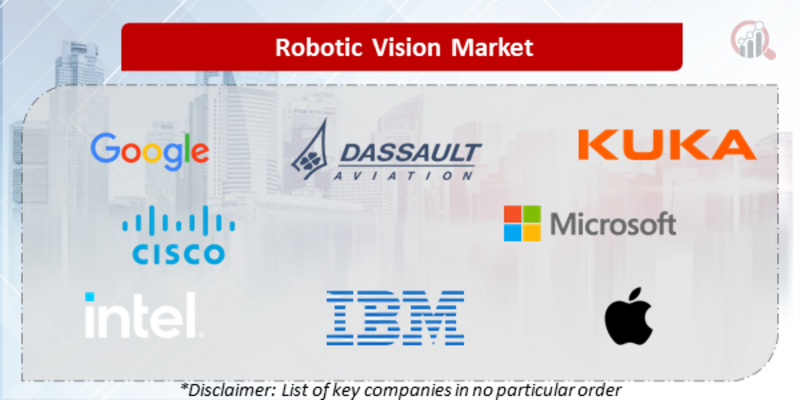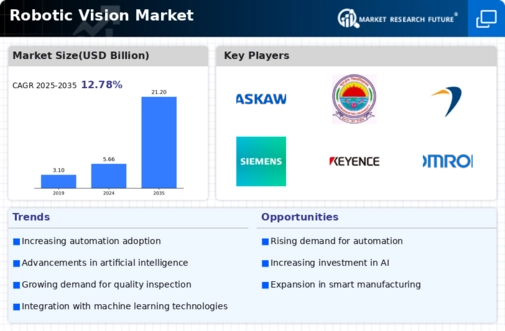Top Industry Leaders in the Robotic Vision Market

Competitive Landscape of Robotic Vision Market:
The robotic vision market, where silicon sensors mimic the human gaze. From guiding robots through factory floors to analyzing medical images, these cybernetic eyes empower machines with sight, transforming diverse industries with their intelligent gaze. In this dynamic arena, established giants and nimble innovators clash, all vying for a clearer view of market dominance. Let's dissect the key strategies and players shaping this captivating scene.
Key Players:
- Google Inc
- Dassault Aviation SA
- KUKA AG
- Cisco Systems Incorporated
- Alphabet
- Microsoft
- Intel
- IBM
- Apple
- Bosch
- Panasonic
Strategies Adopted by key Players:
- Technological Differentiation: Companies compete fiercely on technological advancements, focusing on factors like higher image resolution, faster processing speeds, improved object recognition accuracy, and robust performance in challenging environments. Developing high-dynamic-range cameras, optimizing neural network algorithms, and integrating advanced sensor fusion techniques are key differentiators.
- Expanding Application Reach: Moving beyond traditional applications in industrial automation and logistics to address the needs of diverse sectors like healthcare, agriculture, retail, and security unlocks new market segments and drives wider adoption. Developing specialized vision systems and software for specific applications is crucial.
- Addressing Cost and User-Friendliness: Making robotic vision systems more affordable and user-friendly is vital for widespread adoption. Offering modular and scalable solutions, developing intuitive software interfaces, and reducing deployment and training costs are key strategies.
- Building Partnerships and Collaborations: Fostering partnerships with robotics manufacturers, system integrators, and research institutions accelerates innovation, shares expertise, and expands market reach. Collaborating on industry standards, developing reference designs, and promoting the benefits of robotic vision contribute to market growth.
Factors for Market Share Analysis:
- Revenue Generated: This straightforward metric reflects a company's market penetration and financial strength.
- Number of Vision Systems Deployed: Understanding the volume of deployed systems provides insight into customer adoption and market reach.
- Technology Advancements: Assessing a company's investment in R&D, patent portfolio, and cutting-edge robotic vision technologies helps gauge its future competitive edge.
- Customer Satisfaction: Analyzing user feedback and loyalty metrics reveals how effectively a company caters to customer needs and builds brand reputation.
Latest Company Updates:
November 2023- Roboception has launched its newest robot vision system, the rc_visard NG, which utilizes AI technology. The rc_visard NG smart 3D stereo sensor is powered by Nvidia's Jetson Orin embedded AI platform, providing enhanced computing capacity. This allows for straightforward integration of proven software products with various add-ons, all contained within the sensor itself. The user-friendly design gives robots maximum adaptability. As a result, the rc_visard NG is optimal for intricate and/or compact vision jobs, enabling diverse applications in conventional automation and emerging areas.
November 2023- Tangram Vision’s AI-powered 3D sensor has the potential to revolutionize computer vision in robotics. The sensor strives to make it incredibly easy to incorporate AI-enhanced 3D data into robots. HiFi unites high-resolution 3D sensing with AI processing capabilities and computer vision algorithms embedded directly into the device. This enables it to streamline complex tasks such as calibration, navigation and executing neural networks that are vital for robotics applications but frequently need teams of specialized engineers to put into action. HiFi allows even small teams to leverage sophisticated computer vision capabilities and accelerate the development of robotics products.
September 2023- ZEISS MediTec, the German company renowned for its lenses worldwide, anticipates increased uptake of its robotic laser-guided vision correction technology in India. Through its MediTec division, ZEISS provides technology for vision correction procedures. The company intends to expand availability of its Small Incision Lenticule Extraction (SMILE) treatment, one of the most recent innovations in refractive surgeries, further across India. The SMILE procedure utilizes laser technology that has proven effective in treating the growing prevalence of myopia or near-sightedness. Looking ahead, SMILE Pro, powered by ZEISS's VISUMAX 800 robotic system, would redefine laser vision correction in India.








